Everett White
in the West
[Up]
[Main]
[ORDER]
[Sitemap]

To go directly to images of a particular system, pick from the alphabetical list below, or just scroll down to see them all.
Typeface indicates extent of coverage:
Better coverage · Average coverage · Light coverage
Cedar Rapids & Iowa City
Charles City Western
Chicago, Aurora & Elgin
Chicago, North Shore & Milwaukee
Chicago Rapid Transit
Chicago Transit Authority
Chicago, South Shore & South Bend
Dallas Railway & Terminal
Denver Tramways
Des Moines & Central Iowa
Des Moines Railway
El Paso City Lines
Fort Dodge, Des Moines & Southern
Gary Railways
Illinois Terminal Railroad Co.
Kansas City Public Service Co.
Leonard's M&O Subway (Ft. Worth)
Los Angeles Railway Co.
Milwaukee Electric Railway
New Orleans Public Service
Oklahoma Railway Co.
Pacific Electric
Phoenix Street Railway
Salt Lake, Garfield & Western
Sacramento Northern
San Diego Electric Railway
San Francisco: Market Street Railway, Municipal Railway
Sand Springs Railway
Seattle Municipal Street Railway
St. Louis Public Service
Texas Electric
Union Traction Co.
Utah Power and Light (Salt Lake City)
Waterloo, Cedar Falls & Northern
These images are all frame captures from our digital master. Captions are excerpts from the narration.
Cedar Rapids & Iowa City
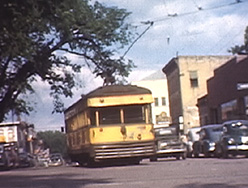
The Cedar Rapids & Iowa City was known as the CRANDIC. The CRANDIC was for the most part moldering away by the time Mr. White got there. He managed to get one shot of a famous CRANDIC Comet in action, cars originally known as the Red Devils of the Cincinatti & Lake Erie. The CRANDIC dropped all passenger service in 1953, but survives today as a successful diesel freight short line.
Charles City Western
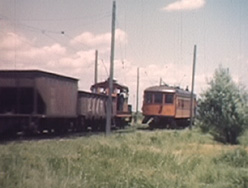 The Charles City Western connected Charles City, Iowa with Colwell to the northeast and Marble Rock to the southwest.
The line never had much passenger traffic - no more than two daily round trips. Passenger service ended in 1952, but electric freight service continued.
Interchange freight was always the line's priority. It connected with the Rock Island's main line at Marble Rock. This siding was at Oakwood.
The Charles City Western connected Charles City, Iowa with Colwell to the northeast and Marble Rock to the southwest.
The line never had much passenger traffic - no more than two daily round trips. Passenger service ended in 1952, but electric freight service continued.
Interchange freight was always the line's priority. It connected with the Rock Island's main line at Marble Rock. This siding was at Oakwood.
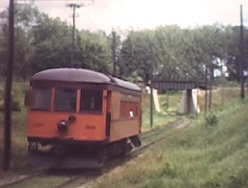
About to pass under the Illinois Central in Charles City.
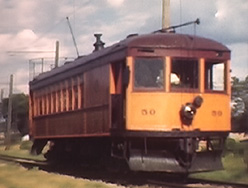
Car 50 had been built for the line by Cummings in 1915, when the line was electrified.
Chicago, Aurora & Elgin Railway
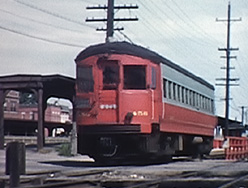
The hub of the Chicago, Aurora & Elgin Railway was at Wheaton, Illinois. It is where the main line east to Chicago split into a branch to the northwest to Elgin, and a branch to the southwest to Aurora.
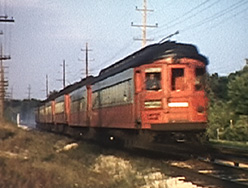
An outbound evening rush hour train approaches Wheaton.
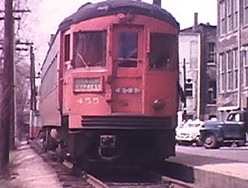
At the terminal in Elgin.
Chicago, North Shore & Milwaukee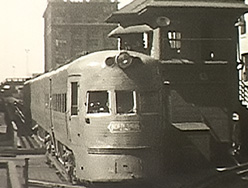
The Chicago, North Shore & Milwaukee - the North Shore Line - was one of three major interurbans serving Chicago, Illinois, connecting it with Milwaukee, Wisconsin. The streamlined train is one of two Chicago, North Shore & Milwaukee Electroliners, delivered in 1941.
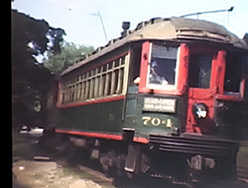
Southbound at the Wilmette station.
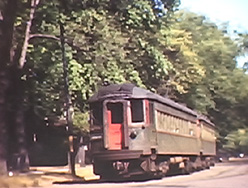
Westbound on Greenleaf Avenue, about to turn north and stop at the Wilmett Avenue in Wilmette.
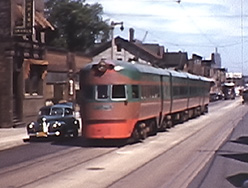
A southbound Electroliner. The Electroliners were articulated, with four body sections permanently coupled together resting on five trucks, a weight-saving measure. With 8 axles powered, they were capable of cruising speeds of 80 miles per hour in regular service. Maximum speed of 100 miles per hour was achieved on an early test run.
Chicago Rapid Transit
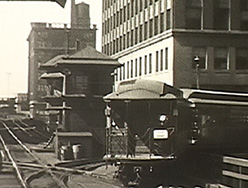
Everett White shot the Chicago Loop and vicinity around 1942. Tower 18 has been called the busiest railway junction in the world.
It sits above the intersection of Lake and Wells streets, and marks the northwest corner of Chicago's famous elevated Loop.
These shots were taken from the north end of the Randolf and Wells station platform looking north along Wells Street.
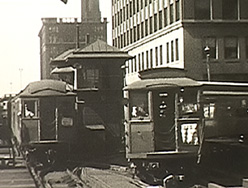
Since 1913 both Loop tracks have been operated in a counterclockwise direction - in 1969 they would change over to operate bidirectionally, right-hand running.

Quincy and Wells station.
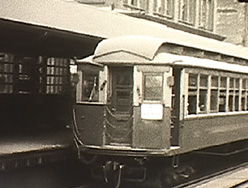
Congress Street station.
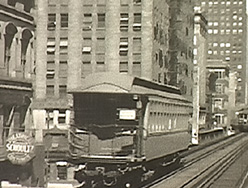
Looking east along Lake Street, the northern leg of the Loop, seen from the Clark and Lake station overpass.
Chicago Transit Authority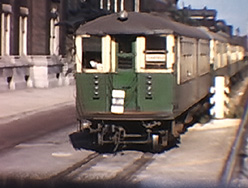
Mr. White filmed the Garfield Park line in the mid-fifties.Green and cream was an early Chicago Transit Authority paint scheme. The CTA was created in 1945 to operate all public transit in the city, under municipal ownership. By 1947 it had acquired the elevateds and the streetcar lines, and took over their operation.
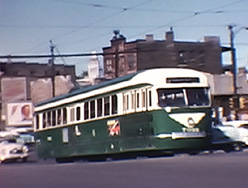
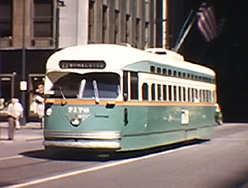
The PCC going north on Western is still wearing a Chicago Surface Lines paint scheme.
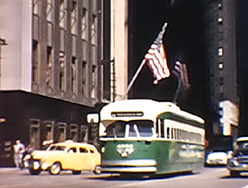
Chicago, South Shore & South Bend
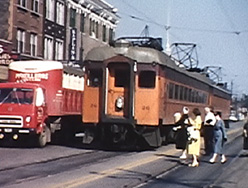
The Chicago, South Shore & South Bend is shown in East Chicago.
Dallas Railway & Terminal
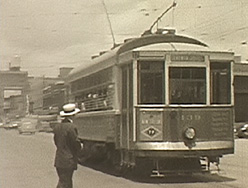
The city cars of Dallas Railway & Terminal shared street trackage in Dallas with the Texas Electric.
It was a Stone & Webster property, which favored turtleback roof cars.
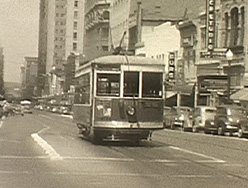
Dallas had a variety of city cars, including these Birneys.
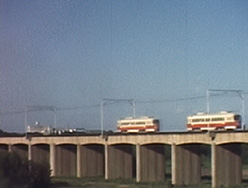
The impressive Trinity River viaduct.
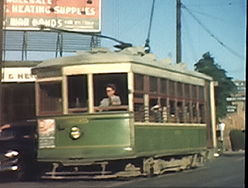
This Birney was on Harwood inbound at Coombs Street.
Denver Tramway Corporation
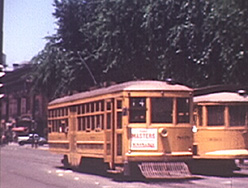
The Denver Tramway Corporation in Colorado operated a 3 foot 6 inch narrow gauge city streetcar system. It also operated both narrow gauge and standard gauge interurban lines to Golden from a downtown loop terminal. They followed entirely different routes.
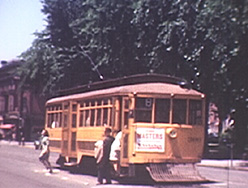
Its cars had unusually varied front window arrangements.
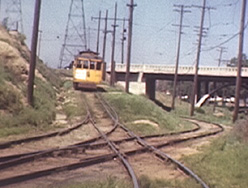
One of the few places in the system with dual gauge track.
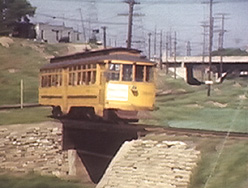
The narrow gauge city car continues on route 75 to Barnum.
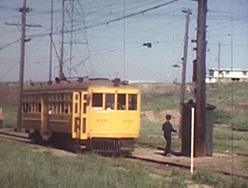
A standard gauge interurban approaches.
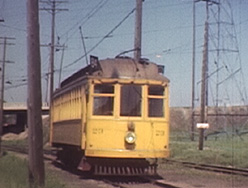
Another standard gauge interurban from Golden. City and interurban service ceased in 1950.
Des Moines & Central Iowa
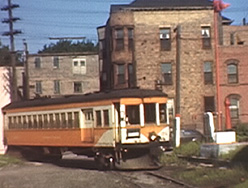
In 1939 the Des Moines & Central Iowa bought three big Jewett steel interurbans secondhand from the Lake Shore Electric in northern Ohio.
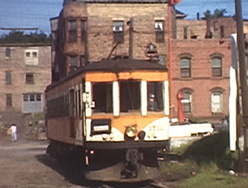
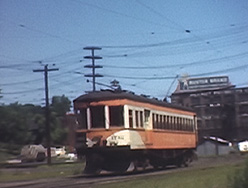
The Des Moines & Central Iowa operated passenger service over its remaining line to Granger until 1949.
Des Moines Railway
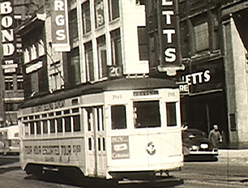
Des Moines Railway operated streetcars in Des Moines, Iowa until 1950.
We're on Grand Avenue in downtown Des Moines.
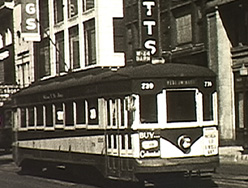
The cars were all part of a batch of 40 built in 1930 by Cummings.
El Paso City Lines
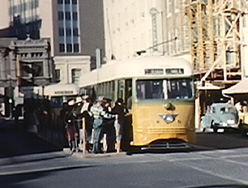
In 1949, El Paso purchased 17 PCC cars from the closed San Diego system.
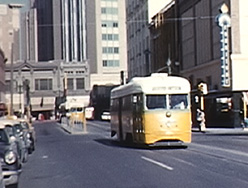
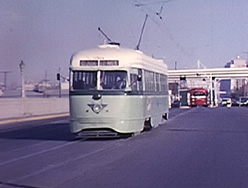
During the 1960s and early 1970s the international streetcar line was repeatedly closed and reopened due to bridge reconstructions, customs house expansion, street widenings, disputes with toll collectors, and eventually the Mexican authorities cancelled El Paso City Lines's right to operate in Mexico. The truncated route on the American side closed for good in 1974.
Fort Dodge, Des Moines & Southern
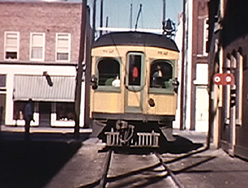
The Fort Dodge, Des Moines & Southern connected its name cities in Iowa, as well as Ames, Rockwell City, Webster City, Lehigh, and Boone.
The line's yard and shops were located at Boone, and this car is backing into the Boone station from the yards to prepare for departure. In its later years the interurban operated one trip a day from Boone to Ft. Dodge, then south all the way to Des Moines, and back to Boone, a 170 mile round trip. The Ft. Dodge Line was the biggest interurban system in Iowa.
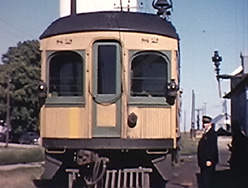
For almost 50 years, the Ft. Dodge Line provided passenger service with a fleet of ten of these 1907-built Niles heavy wooden interurbans. This one is stopped at Boxholm.
Like many Iowa interurbans, the Ft. Dodge line staved off abandonment longer than most by cultivating a carload freight business.
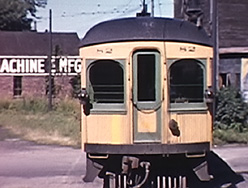
This was the reversing loop at Ft. Dodge.
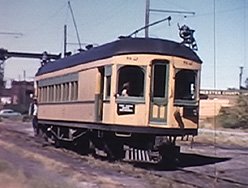
Leaving Ft. Dodge.
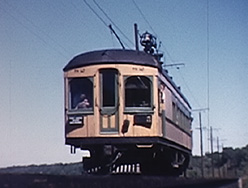
The High Bridge just north of Boone, the tallest interurban structure in the US.
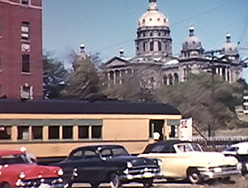
Des Moines, with the Iowa state capitol in the background.
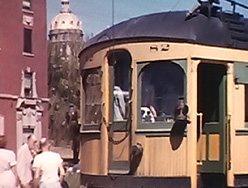
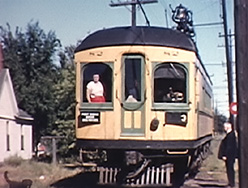
End of the round trip, back in Boone.
Gary Railways
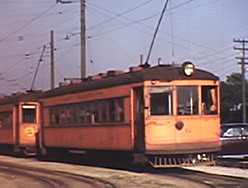
Gary Railways operated city and suburban services until 1947.
Illinois Traction System
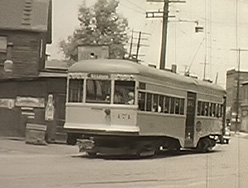
The Illinois Traction System, known later as the Illinois Terminal Railroad, operated interurbans from St. Louis across central Illinois as far as Peoria and Danville. It had ambitions to reach Chicago, but never achieved them. It also operated suburban services in the Illinois suburbs of St. Louis.
This is on the suburban Grafton line.
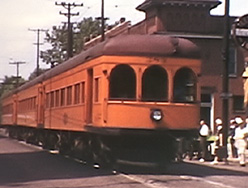
But the Illinois Terminal's main claim to fame was its trains of heavy interurban cars. This one rolls into Staunton, on the main line from St. Louis to Springfield and Peoria.
Kansas City Public Service Company
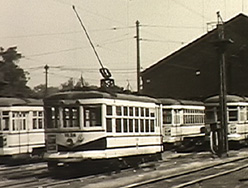
This is behind the Kansas City Public Service Company's barn at 48th and Harrison.
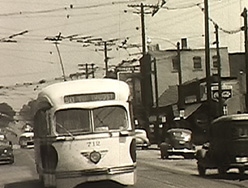
The heavy Route 50 Troost line was being repaired and even extended in these early 1940s views.
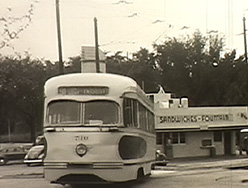
Streetcar service would end in Kansas City in 1957.
Leonard's M&O Subway (Ft. Worth)
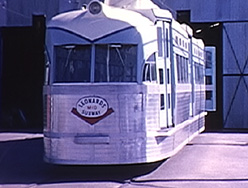
In 1963, Leonards department store constructed a transit line from the basement of their store to a parking lot about 7 tenths of a mile away. They bought 7 PCC cars from the closed Washington, DC system, and modified them extensively, for high-platform loading, and adding a third door at what had been the rear of the car. They made the cars double-ended, but they remained single-sided. Air conditioning was added.
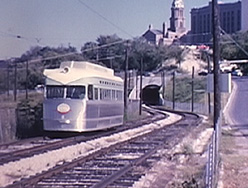
Note the Tarrant County Courthouse of 1895 on the hill in the background.
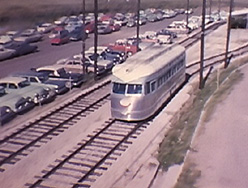
The system was double-track, lefthand running. Each intermediate stop was either available inbound or outbound, but not both.
Los Angeles Railway
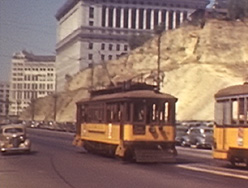
This is a Los Angeles Railway Huntington Standard on Spring Street, just south of its terminal at Sunset.
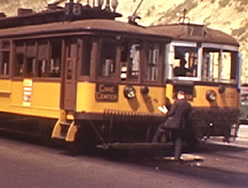
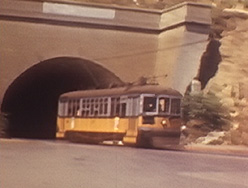
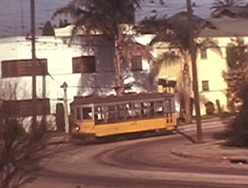
This Birney car is on the Edgeware Road Shuttle.
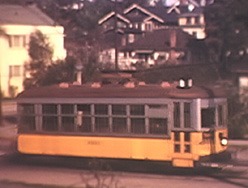
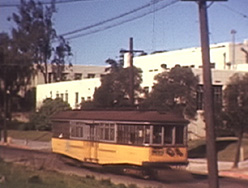
An eastbound car on Monroe at Vermont on the "V" line. That's Los Angeles City College in the background.
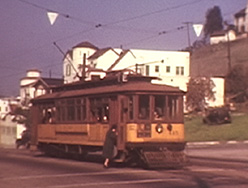
Another Huntington Standard on the "E" line on Ramona Boulevard in East Los Angeles.
The Milwaukee Electric Railway
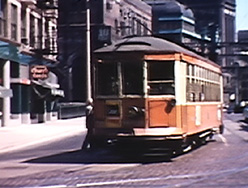
Most streetcar service in Milwaukee was provided by The Milwaukee Electric Railway.
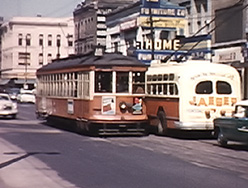
The first and last streetcar service in Milwaukee was the number 10 line on Wells Street, which ran until 1958 to the suburb of West Allis.
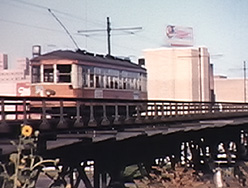
The long trestle was near the Allis end of the line.
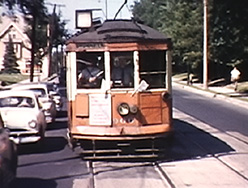
New Orleans Public Service Company
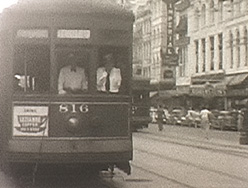
The New Orleans Public Service Company operated an extensive network of streetcar lines in the Crescent City, including a busy four-track mainline along Canal Street, its main thoroughfare. These shots are from around 1940.
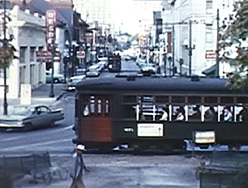
Oklahoma Railway Co.
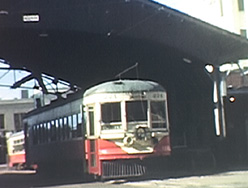
Oklahoma Railway operated three interurban lines centered on Oklahoma City. Oklahoma Railway was an integral part of the Oklahoma City transit system. It operated two other interurban lines, to El Reno and Guthrie, but the Norman line always had more traffic, especially during World War Two, because of military bases. Norman is home to the University of Oklahoma, which also generated traffic. But the end of the war, and automobiles, spelled the end for Oklahoma Railways in the Fall of 1947. This car, under the Oklahoma City trainshed, had been built in 1923 for the Ft. Wayne-Lima Railroad in Indiana and Ohio.
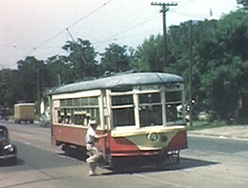
And this car, leaving Oklahoma City on Walker Street, was built for Rockford, Illinois in 1927. Oklahoma bought it and four sister cars in 1936.
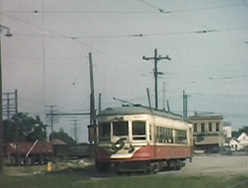
The terminal loop in Norman.
Pacific Electric
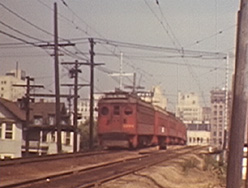
The Pacific Electric operated a network of interurban lines centered on Los Angeles, California. At its peak there were about one thousand miles of track, the largest interurban system in the country. Virtually any point of interest in the Los Angeles area could be reached by Pacific Electric cars.
The large building in the right background is the Pacific Electric's main downtown terminal and corporate offices at 6th and Main Streets. These cars are using the 3-block ramp that carries the tracks up to a two-block elevated that fansout to a 6-track station at the rear of the building. Two of the tracks went through the building, emerging onto Main Street, which was one story higher in elevation than the land at the back of the building.
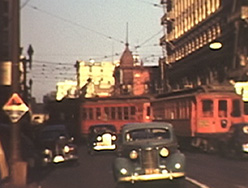
A northbound Venice Short Line train on Hill Street, turning into the Hill Street surface station just beside the Hill Street Subway Station, between 4th and 5th Streets.
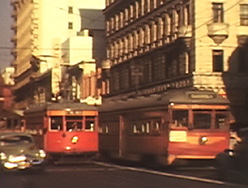
A southbound Echo Park local car and a northbound Hollywood class car on Hill Street.
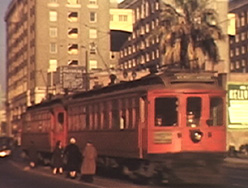
This Venice Short Line train is on Hill Street at Pico.
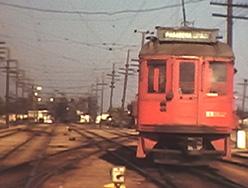
A Pasadena car moves from the express to the local track at Sierra Vista. Pasadena via Oak Knoll cars provided local service from here to the north end of the four-track.
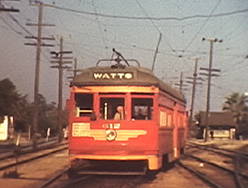
From here south, Watts cars provided most of the local service.
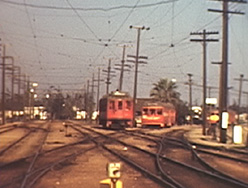
A car on the Watts local line lays over at its northern terminus at Sierra Vista, as the Pasadena car moves north on the local track.
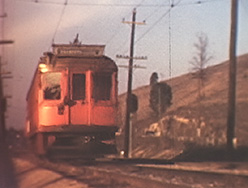
The Pacific Electric had stretches of four-track line both to the north and south of downtown - this is the northern part, with an inbound train.
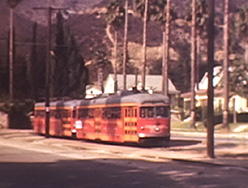
The terminal of the Glendale-Burbank line in North Glendale. The San Gabriel Mountains form the backdrop.
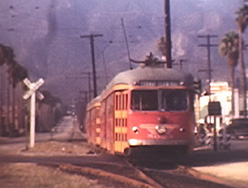
Heading south toward Glendale. The track branching off to the left is the Burbank line. This 4 mile branch was single track on private right-of-way.
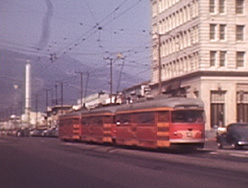
On Brand Boulevard in downtown Glendale.
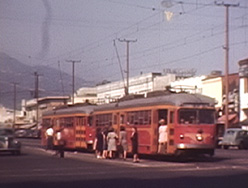
These double-ended PCCs, there were 30, were the last cars ever bought by the Pacific Electric, in 1940. They saw most of their service on the Glendale-Burbank line. After the Pacific Electric discontinued rail service, the cars were sold to the General Urquiza Railroad for use on their suburban lines out of Buenos Aires, Argentina.
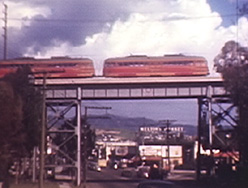
The high trestle over Fletcher Drive in the Elysian Hills.
Phoenix Street Railway
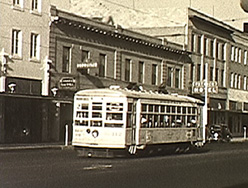
In the last years, Phoenix Street Railway in Arizona operated service over 4 lines with 17 double-truck Birneys from American Car Company. In 1947, a carbarn fire destroyed all but 6 cars, and the system went all-diesel the next year. Mr. White got only a single shot, probably during the early 1940s.
Salt Lake, Garfield & Western
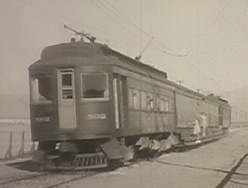
The Salt Lake, Garfield & Western operated electric passenger trains from Salt Lake City to the Saltair resort until 1951, then dieselized.
Sacramento Northern
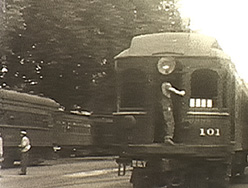
The Sacramento Northern connected Sacramento, California with Chico to the north, and San Francisco to the south, a total of 183 miles. The San Francisco to Chico through trains were the longest interurban run in the country. The Sacramento Northern had shared Union Terminal in Sacramento (shown here) with the Central California Traction Company until the latter discontinued interurban passenger service in 1933. Sacramento Northern's interurban service ended in 1941. However their local streetcar service in Sacramento continued until 1944.
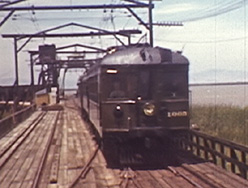
Approaching the Sacramento Northern's crossing of Suisun Bay on the ferry Ramon in the background. It was one of only two interurban car ferries in the country.
San Diego Electric Railway
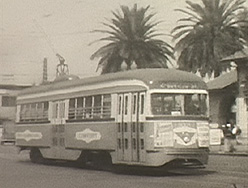
San Diego was an early adopter of the PCC cars - their first order was placed in 1936. During World War Two, when these views were filmed, you could see a virtual parade of historic cars.
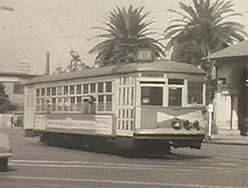
These cars were built for San Diego by the American Car Company in 1924.
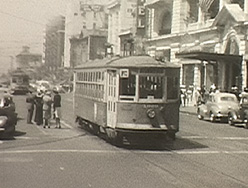
Broadway, San Diego's main drag. This second hand car came from Wilkes-Barre Railways.
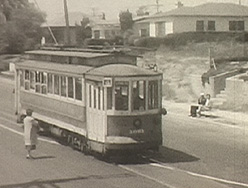
This wood-bodied oldtimer from 1906 came to San Diego third-hand, from New York Railways via Third Avenue Railways. It is on Imperial Avenue, approaching the underpass of the San Diego & Arizona Eastern, nearing the end of the number four line.
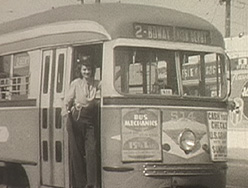
During the war transit ridership went up 600%, so women got a shot at operating. Most of San Diego's PCCs were sold to El Paso after streetcar service ended in 1949.
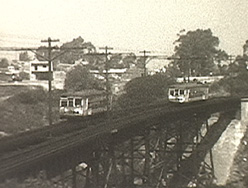
There were three steel trestles in Balboa Park, where the famous San Diego Zoo is located. This is the middle one.
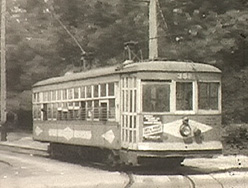
This car is on a shuttle from the ferry terminal on Coronado Island to the Hotel Del Coronado. There was no track connection between this short line and the rest of the system.
Market Street Railway, San Francisco Municipal Railway
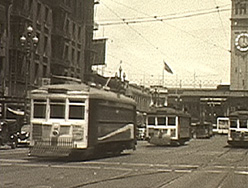
The four tracks on Market Street in San Francisco carried cars of the Market Street Railway on the inside tracks, and the San Francisco Municipal Railway on the outer tracks. The two systems would merge in 1944, and the four tracks would be reduced to two a year later. The San Francisco scenes were shot in 1940.
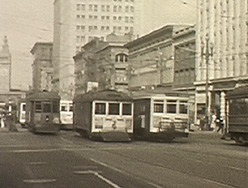
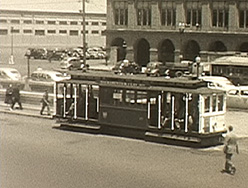
The Sacramento-Clay cable car line, shown here at its Ferry Building terminal, was dieselized in 1942.
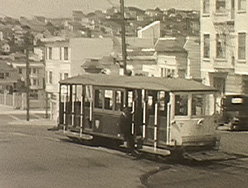
The less-than-one-mile Castro Street cable car line was the last remnant of the once-mighty Market Street Cable Railway. This was the outer terminal at Castro and 26th Street. The fact that it had steep grades saved it until more powerful diesel buses came along in 1941.
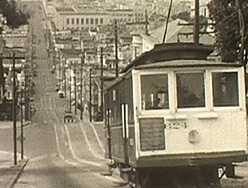
Not a cable car line, but the Fillmore Street counterbalance. Because two electric cars were attached to opposite ends of an unpowered cable, every other trip had to be left-hand running like the one shown (note the angle of the trolley pole).
Sand Springs Railway
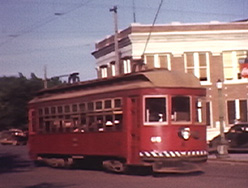
Sand Springs was a 10-mile suburban line from Tulsa to Sand Springs, Oklahoma. The Sand Springs Railway had been built by the oil millionaire and philanthropist Charles Page to serve a home for widows and orphans he had founded there. This car is waiting to depart from Tulsa for Sand Springs.
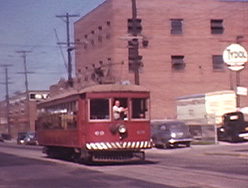
This car was one of the lightweights built by the American Car Company for Union Traction. They came to Sand Springs when the Union Traction closed in 1947.
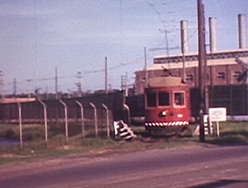
Note the industrial development, another Charles Page initiative, which generated substantial freight traffic. Diesel freight operation continues, long after passenger service was discontinued in 1955.
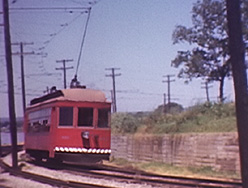
The car is turning west to follow the north bank of the Arkansas River.
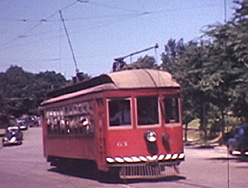
At the Sand Springs end of the line.
Seattle Municipal Street Railway
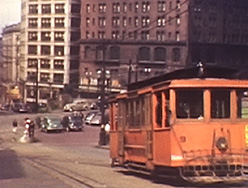
A Yesler Way cable car in Seattle, Washington approaches its in-town terminal at Pioneer Square.
The Yesler Way cable car was the first to open and the last to close in Seattle, in 1940.
It was the last surviving cable car line outside San Francisco in North America, in fact in the entire world except for 4 very short lines in New Zealand.
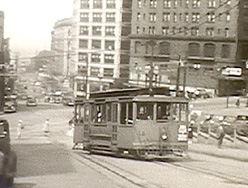
The cars were originally open at both ends like the California Street cars in San Francisco. They were enclosed before World War One.
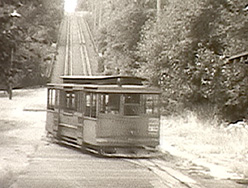
Approaching the Lake Washington terminal, two and one-half miles from Pioneer Square.
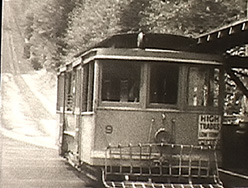
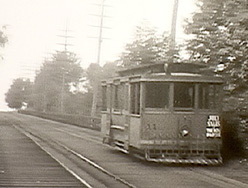
This 18% grade was steeper than any of the grades in San Francisco's current system except the steepest part of Hyde Street.
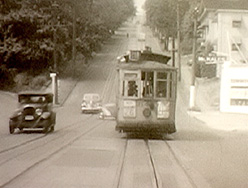
This may look like a cable car - see the slot in the tracks? - but it wasn't. It was the Queen Anne Hill counterbalance. The cars were conventional electrically-powered streetcars getting an assist going up and down the hill by a counterweight on the end of a cable.
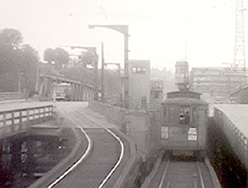
Seattle's electric streetcar system featured an elevated, originally quite a bit longer than the section shown here, probably in 1940. The entire system closed only a year later.
St. Louis Public Service
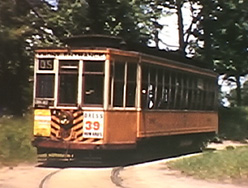
A Route 5 Creve Coeur Lake car turns back at Crows Nest Loop...
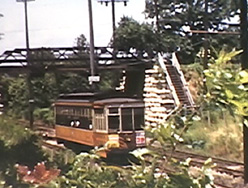
and passes under the Ashby Road bridge.
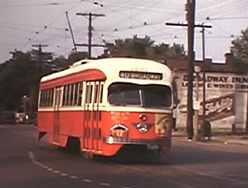
The Route 40 Broadway car is probably at Catalan Loop.
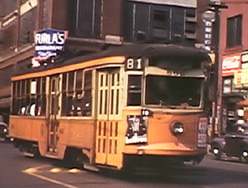
A Route 81 Park car at Union Station.
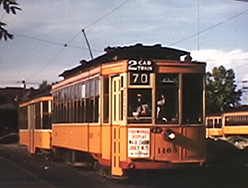
At Kossuth Yard. St. Louis Public Service used two-car trains for ball park crowds.
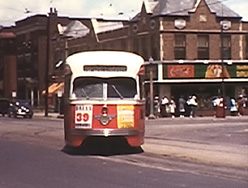
A Route 10 Delmar car exiting Kingsland Loop.
Texas Electric Railway
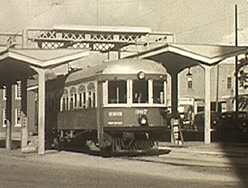
The Texas Electric Railway operated interurban lines from Dallas to Denison to the north, and Waco and Corsicana to the south.
They had an impressive interurban terminal on Jackson Street in downtown Dallas where cars departed for their three lines to Denison, Waco, and Corsicana.
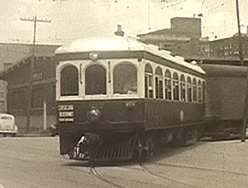
A few blocks down Commerce Street and around the corner on Record Street the Texas Electric had a freight terminal.
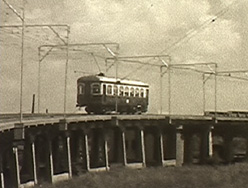
Climbing the approach to the impressive Trinity River viaduct.
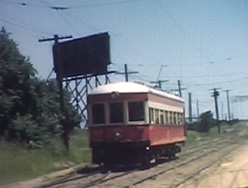
Coming down off the Trinity River viaduct.
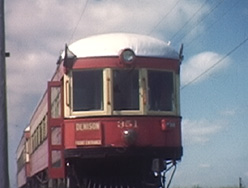
At Perkins on the line to Denison.
Union Traction Company
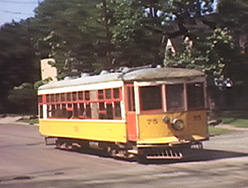
The Union Traction Company, also known as the Union Electric Railway, operated north from Coffeyville, Kansas, through Independence and Cherryvale, to Parsons, and southward to Nowata, Oklahoma. Passenger service was provided with a fleet of six lightweight cars built by the American Car Company in 1925.
Departing from Coffeyville for a run only as far as Cherryvale. These scenes were probably filmed shortly before abandonment in 1947.
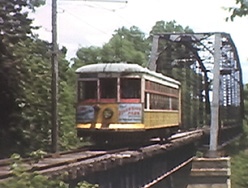
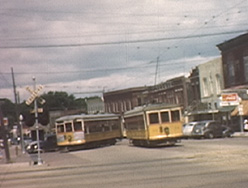
In Cherryvale, the car on layover switches briefly into a siding to allow the outbound car into the pocket.
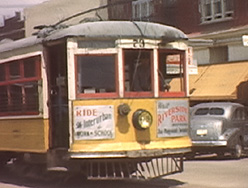
Inbound to Coffeyville.
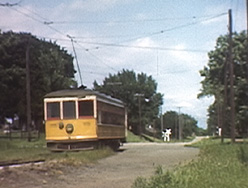
Leaving Cherryvale.
Utah Power & Light
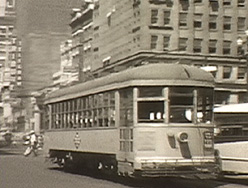
Utah Power & Light operated the city cars in Salt Lake City until 1945.
Waterloo, Cedar Falls & Northern
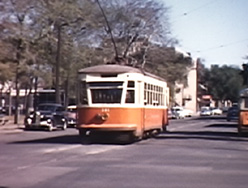
The Waterloo, Cedar Falls & Northern in Iowa connected Waterloo with both Cedar Falls and Cedar Rapids.
The Cedar Valley Road operated service over its original 1897 line to Cedar Falls with streetcar type equipment. The schedule was as frequent as every 30 minutes.
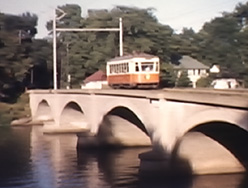
The bridge is over the Cedar River. Service ended in 1958.
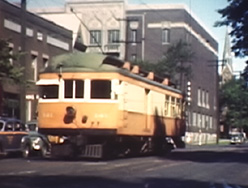
This big interurban being loaded in Waterloo is bound for Cedar Rapids. It was one of 7 built by McGuire-Cummings in 1914. The trip to Cedar Rapids took about two hours. It was discontinued in 1956.
[Up]
[Main]
[ORDER]
[Sitemap]






































































































































